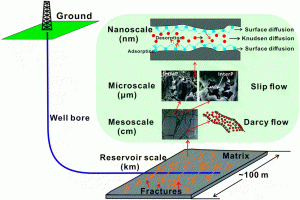Methane Adsorption-Desorption Hysteresis and Its Effect on Shale Gas Production
解吸是页岩气藏的主要气体运移机制之一。然而,在储层条件下的天然气产量计算过程中,不加选择地使用吸附衍生参数计算解吸气体体积,往往掩盖了其对天然气产量的实际贡献。
传统上,人们认为在高压、高温条件页岩气储层中吸附是完全可逆的。然而,研究表明,解吸等温线往往不同于吸附等温线,并且与吸附等温线表现出滞后性。高温高压下这种滞后行为的原因尚不清楚,目前还没有吸附滞后对页岩气藏生产动态影响的相关研究。
本文使用Particulate系统HPVAII®200设备,在25℃、40℃、60℃和80℃的温度和高达7MPa的压力下,研究甲烷的吸附和解吸等温线,首先是煤样品,然后是西澳大利亚坎宁盆地奥陶系戈德维尔组的页岩样品。煤样用于测试状态方程(EOS)对测量等温线及其后续应用的影响。煤的使用消除了页岩的复杂性,并避免了使用不同EOS产生的流体密度的影响。六种流行的EOS进行数据解释,即Peng Robinson’s(PR)、Soave-Redlich-Wonk’s(SRK)及其体积转换形式(PRPeneloux和SRK Peneloux)、Soave’s modified Benedict-Webb-Rubin’s (SBWR), and LeeKesler’s (LK)。
使用三参数Langmuir模型来描述每个吸附等温线,结果表明,所有测试的状态方程在测量等温线、计算模型参数,观察到的吸附滞后类型和程度以及原始储量等得出不同的推导结果,这是由于计算的氦和甲烷Z因子相对于Nisrefprop的变化。 尽管滞后大小与温度之间的关系不一致,但各个样品在所有温度下都观察到明显的滞后现象。解吸等温线导致模型参数低于相应的吸附等温线。对于这两种过程,朗缪尔体积与总有机碳(TOC)含量呈正相关,但与总粘土含量无显著相关。采用一种新型总粘土(Total Clay)与TOC的比值(即粘土与有机碳的比值,COC)作为单一预测因子,其显示出与朗格缪尔体积的良好相关性(R2值与总有机碳的相关性相当)。滞后的大小,以及低压吸附实验确定的BET表面积和孔隙体积,也与TOC含量和COC显著相关。
最后,使用CMG-GEM开发了一个多组分,多重连续作用域(MINC)模型,测试在储层条件下观察到的滞后作用对页岩气产量的影响。每个样品都进行有吸附、解吸对比;一个是吸附朗缪尔参数(吸附情况),另一个是解吸朗缪尔参数(解吸情况)。模拟结果表明,如果不考虑气体吸附,气体产量可能会显著低于预测值,但使用吸附等温线代替解吸可能会导致气体产性能的预测过高。

Abstract
Gas desorption is one of the major gas transport mechanisms in shale gas reservoirs. However, its actual contribution to gas production is often masked by the indiscriminate use of adsorption-derived parameters for desorbed gas volumes during gas production calculations at reservoir conditions. Traditionally, it is believed that gas adsorption is fully reversible at the high-pressure, high-temperature conditions found in shale gas reservoirs. However, research has shown that desorption isotherms are often different from, and often show hysteresis with their adsorption counterparts. But, the cause of this hysteresis behavior at high temperature and high pressure remains unclear. More importantly, the implications of sorption hysteresis on production performances of shale gas reservoirs have not been previously studied.
In this study, adsorption and desorption isotherms of methane were studied at temperatures of 25oC, 40oC, 60oC, and 80oC and pressures up to 7 MPa using the Particulate System’s HPVAII® 200 equipment first for a coal sample and then for shale samples from Ordovician Goldwyer Formation, Canning Basin, Western Australia. The coal sample was used to test the effect of equations of states (EOSs) on the measured isotherms and their subsequent applications. The use of coal eliminated the complexities of shale and isolated the effect of fluid densities resulting from the use of different EOSs. Six popular EOSs namely PengRobinson’s (PR), Soave-Redlich-Wonk’s (SRK) and their volume translated forms (PRPeneloux and SRK-Peneloux), Soave’s modified Benedict-Webb-Rubin’s (SBWR), and LeeKesler’s (LK) were used for data interpretation and the results were compared with those calculated by the equipment using Z-factors from the equipment’s software implementation of McCarty and Arp’s EOS for helium and Setzmann & Wagner’s EOS for methane (a combination subsequently referred to as NIST-refprop®).
The three-parameter Langmuir model was used to describe each of the adsorption isotherms and the results showed that all the equations of state tested gave varied deviations in the measured isotherms, calculated model parameters, observed type and degree of sorption hysteresis and original gas in-place because of the variations in the calculated Z-factors of both helium and methane relative to NISTrefprop. Consequently, the SWBR EOS was selected for studies involving the shale samples. Early pore saturation, indicated by maximum excess adsorptions at pressures in the neighbourhood of the critical pressure of methane, was also observed for all the shale samples. Consequently, the measured sorption isotherms could not be represented directly by three parameter Langmuir model. Therefore, a two-step modelling approach was adopted. First, each excess adsorption isotherm was modelled using Dubinin–Radushkevich (D-R) model to obtain the adsorbed phase density used to convert both the adsorption and desorption amounts to their absolute equivalents. In the second step, and based on the intended application of the results, the conventional Langmuir model was used to describe the resultant absolute adsorption and desorption isotherms.
Significant hysteresis was observed for all samples at all temperatures, albeit the relationship between the size of the hysteresis and temperature was inconsistent. Desorption isotherms resulted in lower model parameters than the corresponding adsorption isotherms. For both processes, Langmuir volumes positively correlated with TOC contents but show no significant correlations with total clay contents. A novel ratio of total clay to TOC (i.e. clay-to-organic-carbon, COC) applied as a single predictor showed good correlations with Langmuir volumes (R2-values comparable to those of correlations with TOC). The size of the hysteresis, as well as the BET surface areas and pore volumes determined from low-pressure adsorption experiments, also showed significant correlations with TOC contents and COC. Lastly, a compositional 3D multiple interacting nested continua (MINC) model was developed in CMG-GEM® to test the effect of the observed hysteresis at reservoir conditions on shale gas production. For each sample, a base scenario, corresponding to a “no-sorption” case was compared against two other cases; one with adsorption Langmuir parameters (adsorption case) and the other with desorption Langmuir parameters (desorption case). The simulation results showed that while gas production can be significantly under-predicted if gas sorption is not considered, the use of adsorption isotherms in lieu of desorption can lead to over-prediction of gas production performances.


